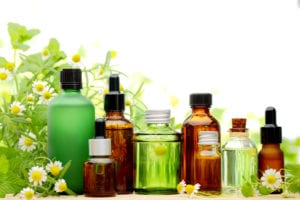Written by Joyce Smith, BS. Herbal extracts may be a new therapeutic option for non-drug users with mild to moderate acne vulgaris.
 Clinical trials have provided many therapeutic options for acne treatment; however, it continues to be a common inflammatory disease among adolescents and young adults. Treatment modalities include systemic and topical agents that target inflammation, excessive sebum (oily secretion) production, follicular hyperkeratinization, and Cutibacteriun acnes (commensal bacteria on the skin) 1. The adverse side effects of treatments with antibiotics and isotretinoin (13-cis-retinoic acid sold under the brand name Accutane) have given credence to the development of new treatment options with fewer side effects 2. Mangosteen extract, which has few side effects, is both an anti-inflammatory 3 and a potent antibacterial against C. acnes 4. Lithospermum officinale, has been shown to possess both anti-inflammatory and antioxidant activities 5 while Tribulus terrestris L. 6 and Houttuynia cordata Thunb are known for their therapeutic potentials against inflammation 7. Thus in a current double-blind, randomized clinical trial 8, researchers, searching for a potential alternative treatment for acne medications, investigated the healing potential of these herbal extracts and examined the various molecular pathways of acne pathogenesis that they potentially target.
Clinical trials have provided many therapeutic options for acne treatment; however, it continues to be a common inflammatory disease among adolescents and young adults. Treatment modalities include systemic and topical agents that target inflammation, excessive sebum (oily secretion) production, follicular hyperkeratinization, and Cutibacteriun acnes (commensal bacteria on the skin) 1. The adverse side effects of treatments with antibiotics and isotretinoin (13-cis-retinoic acid sold under the brand name Accutane) have given credence to the development of new treatment options with fewer side effects 2. Mangosteen extract, which has few side effects, is both an anti-inflammatory 3 and a potent antibacterial against C. acnes 4. Lithospermum officinale, has been shown to possess both anti-inflammatory and antioxidant activities 5 while Tribulus terrestris L. 6 and Houttuynia cordata Thunb are known for their therapeutic potentials against inflammation 7. Thus in a current double-blind, randomized clinical trial 8, researchers, searching for a potential alternative treatment for acne medications, investigated the healing potential of these herbal extracts and examined the various molecular pathways of acne pathogenesis that they potentially target.
Sixty participants with mild to moderate acne were randomized in a 1:1 ratio to use either herbal extracts or a vehicle cleanser on their acne lesions for 8 weeks. The herbal extract cleanser, which contained a combination of mangosteen, Lithospermum officinale, Tribulus terrestris L., and Houttuynia cordata extracts, was assessed using inflammatory and non-inflammatory acne lesions counts, Investigator Global Assessment to evaluate acne severity, and patient satisfaction and safety. In addition, the researchers performed skin biopsies and immunohistochemistry staining at baseline and week 8 to confirm immunological changes.
After 8 weeks of treatment, participants treated with herbal extracts had significantly decreased inflammatory and non-inflammatory acne lesion counts compared to the vehicle-treated group. In fact, the herbal extract group showed a tendency to continuously decrease acne lesions by 56% from baseline to week 8 while the vehicle group’s acne lesions decreased only 17% (p=0.005). Non-inflammatory lesions also decreased significantly more in the treatment group (36%) compared to 12 % in the vehicle group (p=0.028). In addition, skin biopsies at eight weeks and immunohistochemistry staining revealed significantly decreased expression of IL-1α, IL-8 and keratin 16 (which represents abnormal follicular keratinization in acne lesions). The combination of mangosteen, Lithospermum officinale, Tribulus terrestris L., and Houttuynia cordata extracts may have collectively resulted in the reduction of the inflammatory acne lesions.
These results demonstrate that “Herbal extracts may be a new therapeutic option for patients with mild to moderate acne vulgaris who are reluctant to use drugs”.
Source: Yang, Ji Hoon, Eun Ju Hwang, Jungyoon Moon, Ji Young Yoon, Ji Won Kim, Sungjun Choi, Soo Ick Cho, and Dae Hun Suh. “Clinical efficacy of herbal extracts in treatment of mild to moderate acne vulgaris: an 8-week, double-blinded, randomized, controlled trial.” Journal of Dermatological Treatment (2019): 1-5.
© 2019 Taylor & Francis Group, LLC
Posted February 17, 2020.
Joyce Smith, BS, is a degreed laboratory technologist. She received her bachelor of arts with a major in Chemistry and a minor in Biology from the University of Saskatchewan and her internship through the University of Saskatchewan College of Medicine and the Royal University Hospital in Saskatoon, Saskatchewan. She currently resides in Bloomingdale, IL.
References:
- Suh DH, Kwon H. What’s new in the physiopathology of acne? British Journal of Dermatology. 2015;172:13-19.
- Yoon JY, Kwon HH, Min SU, Thiboutot DM, Suh DH. Epigallocatechin-3-gallate improves acne in humans by modulating intracellular molecular targets and inhibiting P. acnes. Journal of Investigative Dermatology. 2013;133(2):429-440.
- Chen L-G, Yang L-L, Wang C-C. Anti-inflammatory activity of mangostins from Garcinia mangostana. Food and Chemical Toxicology. 2008;46(2):688-693.
- Pothitirat W, Chomnawang MT, Gritsanapan W. Anti-acne-inducing bacterial activity of mangosteen fruit rind extracts. Medical principles and practice. 2010;19(4):281-286.
- Amiri ZM, Tanideh N, Seddighi A, et al. The effect of lithospermum officinale, silver sulfadiazine and alpha ointments in healing of burn wound injuries in rat. World journal of plastic surgery. 2017;6(3):313.
- Lee HH, Ahn EK, Hong SS, Oh JS. Anti-inflammatory effect of tribulusamide D isolated from Tribulus terrestris in lipopolysaccharide-stimulated RAW264. 7 macrophages. Molecular medicine reports. 2017;16(4):4421-4428.
- Shingnaisui K, Dey T, Manna P, Kalita J. Therapeutic potentials of Houttuynia cordata Thunb. against inflammation and oxidative stress: A review. Journal of ethnopharmacology. 2018;220:35-43.
- Yang JH, Hwang EJ, Moon J, et al. Clinical efficacy of herbal extracts in treatment of mild to moderate acne vulgaris: an 8-week, double-blinded, randomized, controlled trial. Journal of Dermatological Treatment. 2019:1-5.
